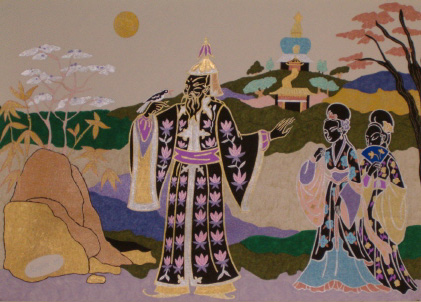
Mayken González Backlund’s illustration for “The Nightingale”
I’ve been doing some reading on Hans Christian Andersen lately, and it’s really spurred me to think about my own interactions with art. In addition to reading Andersen’s tales, I’ve been reading Jack Zipes’s book Hans Christian Andersen: The Misunderstood Storyteller, which (in my opinion) does a great job of using contextual information from Andersen’s life to illuminate his fairy tales and stories.
Fun fact: Andersen never married, and is believed to have never had sex (despite apparently visiting brothels a couple of times in his life). Contemporary scholars debate whether he was gay, bisexual, or “spiritually androgynous” yet asexual in practice. Based on the fact that he proposed to two women, and yet in numerous letters and diary entries described his passionate feelings for men, it seems likely that he wasn’t 100% heterosexual (as much as that category existed in 19th century Denmark or anywhere else for that matter). Either way you slice it, he felt like he didn’t fit in and was thus lonely and misunderstood.
Perhaps related to his loneliness was his drive to create. He was amazingly prolific, penning not just the tales we know and love him for, but also poetry, essays, novels, plays, travel books, and memoirs. Zipes gives us a quote from one of his diaries:
What could become of me, and what will become of me? My powerful fantasy will drive me into the insane asylum, my violent temper will make a suicide of me! Before, the two of these together would have made a great writer. (7)
Other quotes reveal that Andersen believed he was guided by God to become a great artist, that he had a gift to share with the world. In Andersen’s tales, too, we see notions of inner nobility (such as in “The Ugly Duckling”) and ruminations on the nature of art (“The Nightingale”)… and those are just from some of his better-known works! There are tons more.
All this has me thinking, as an artist, about what makes me similar to and different from Andersen. I also feel driven, perhaps to the point of narcissism and solitude. I don’t, however, believe that I have a God-given destiny to become an artist… though I do feel like I have talents and skills that I ought to use, if only because I have them and don’t want them to get rusty. When it comes down to it, what’s the difference between the two? If I believe I have a gift and ought to use it to create art, does it really matter whether I believe it came from God or is just a part of my personality and makeup?
One of Andersen’s tales, “The Pen and the Inkwell,” shows the two titular objects arguing over which of them has agency and is thus responsible for creating the masterpieces they write. The poet who wields them ends up writing a parable about how the bow and violin that create marvelous music are not, however, the creators of their art:
“How absurd it would seem if the bow and the violin should be proud and haughty about their accomplishments. Yet we, human beings, often are: the poets, the artists, the scientists, and even the generals often boast in vain pride. Yet they are all but instruments that God plays upon. To Him alone belongs all honor. We have nothing to pride ourselves upon!” (Hans Christian Andersen: The Complete Fairy Tales and Stories, trans. Erik Christian Haugaard, 640)
I believe that artistic inspiration comes from somewhere, but that “somewhere” doesn’t need to have a religious explanation tacked on to it in order to be meaningful. The important thing about art is that it moves us, not where it comes from. To be sure, many artists use art therapeutically, to resolve feelings and address struggles – so in that sense, yes, it matters where art comes from. But I don’t think that the only rational or valid origin for art lies in religion.
To me, a more powerful account of art can be seen in “The Nightingale.” A nightingale that sings miraculously beautiful songs agrees to come and sing for the emperor, but it’s banished after a mechanical bird arrives and sings flawless, perfect (but ultimately boring and unchanging) music. After all this, the nightingale returns and sings for Death before Death can claim the emperor’s life. Art is so moving that is can persuade Death to leave – and it almost teaches the emperor a valuable lesson about de-commodifying art. Almost. The emperor still wants art on his terms, but relents and agrees to let the nightingale come and go as it pleases.
Perhaps there are people who will never understand how artists and art work, but as long they’re able to enjoy its beauty from time to time, this tale suggests, then our worlds will intersect and enlighten one another. Perhaps art doesn’t always provoke lasting social change, but moments of reflection are still worthwhile.
One of the enduring gifts that Andersen gave the world was his meta-art, or his art that reflects on art. I appreciate this as both an artist and a scholar, and I continue to seek it out in my engagements with others. If nothing else, connecting with others (such as collaborating) prevents me from going to the extreme of hermiting myself up all the time or becoming too proud. Encounters with others always have the potential to be humbling, and if we read into and across Andersen’s tales, we find the encouragement to engage, encounter, and transform.
